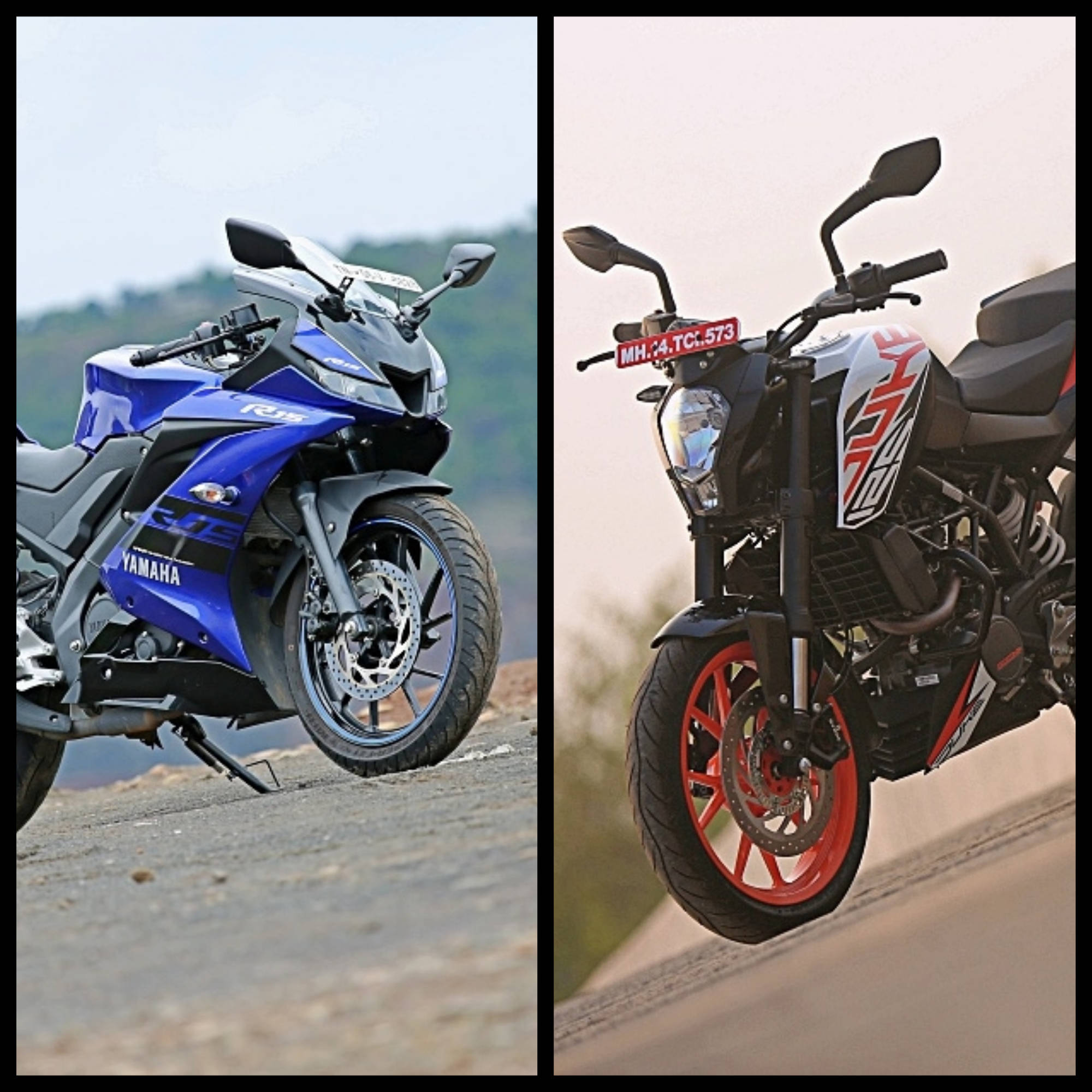KTM 125 Duke Vs Yamaha YZF-R15 v3 ABS: Spec Comparison
Modified On March 20, 2019 12:30 IST
By Mallikarjun Pillai for Yamaha yzf r15 v3
- 10478 Views
We pit two of the country’s best entry-level performance-oriented motorcycles against each other on paper

The KTM 125 Duke is a great example of seeing an opportunity where no one else does. KTM surprised everyone by launching the bike at a price that comfortably exceeded that of most 150cc bikes. In fact, the smallest Duke matches most 150cc bikes when it comes to engine output and excels almost all of them in outright dynamic ability. However, the Yamaha YZF-R15 v3.0 is not just any other 150cc bike. It’s the most powerful 150cc motorcycle in India today and offers the sort of dynamic ability that fully justifies its supersport tag. So what’s the common thread that binds these two motorcycles? Price-to-performance ratio. For now, we pit the KTM 125 Duke against the Yamaha YZF-R15 v3.0 ABS on paper to see which bike offers the most performance for the buck.
Design & Features
Both the R15 v3.0 and the 125 Duke are instantly reminiscent of the family lineage they belong to. While the R15 v2.0 had a friendlier demeanour, the v3.0 comes across like it means business. The front is dominated by a faux air duct that is flanked by sharp LED headlamps. The gill-shaped vents on the fuel tank and a cleanly finished rear end further do their bit in reinforcing the R15’s sporty intent. But the bike’s style is not without substance as it gets useful features like a fully-digital intrument console that has read outs for gear position, instantaneous and average fuel consumption and of course, VVA (variable valve actuation).

Also read: Yamaha YZF-R15 v3.0 ABS Launched
The best way to summarise the 125 Duke’s design is that it could easily be mistaken for the 200 Duke, except for the stickers. That is not to say the baby Duke looks outdated. It’s just that the bike’s design is a lot more familiar and recognisable than the Yamaha. The sporty cuts and streaks that dominate the 125 Duke’s design still help it stand out from the crowd, or given its target buyer, the college crowd. Like the Yamaha, the 125 Duke too gets an info-laden fully-digital instrument console.

While the two are neck-to-neck when it comes to features, the KTM boasts of higher-quality plastics and finish. This is a surprise since Yamaha is traditionally known to be right up there in terms of parts quality and overall fit and finish. However, picking a winner is easier when it comes to looks. The R15 makes the cut owing to its newer, and therefore, fresher design.
Engine & Transmission
Two things have always been central to the magical R15 experience. One of these is the engine (we’ll come to the other one shortly), which has seen a power bump with the R15 v3.0. It now displaces 155cc (compared to the v2’s 149cc) and pushes out 19.3PS of power and 15Nm of torque. The single-cylinder, liquid-cooled, 4-valve motor also gets Yamaha’s VVA (variable valve actuation) technology, which helps it run two different valve timings. This gives the R15 better low-end rideability without sacrificing any of its signature top-end grunt. Transmission duties are handled by a slick 6-speed gearbox with well-spaced ratios.
Also read: 2018 Yamaha YZF-R15 V3.0 Road Test Review

Small but mighty is an apt way to describe the 125 Duke’s heart. The 124.7cc single-cylinder, liquid-cooled engine produces 14.5PS of power and 12Nm of torque, mated to a 6-speed gearbox. While it may lose out to the larger single-cylinder Dukes in terms of absolute power, it’s superior to them in terms of refinement. Gone is the manic power delivery of its elder siblings and what you get instead is a highly tractable, refined and friendly engine. KTM has further tweaked the gear ratios in a way that offers a good balance of performance and fuel efficiency.

On paper, the R15 v3 is obviously more powerful than the 125 Duke. However, the latter is the friendlier of the two and that might just appeal to those looking for a not-so-steep learning curve with their first performance bike.
Also read: KTM 125 Duke First Ride Review
Underpinnings
The other half of the duo responsible for creating the R15 magic is the chassis. Although the v3.0 continues to use the Deltabox frame, it’s now sharper than ever. The bike really means business come the corners and requires the rider to be fully invested. Yamaha has given the R15 v3.0 a sharper rake and a shorter wheelbase than both the previous generation bikes and this has made all the difference. Suspension duties are handled by fatter 41mm telescopic forks at the front and a linked monoshock at the rear. Yamaha has also equipped the R15 with dual-channel ABS, which should result in safer stopping performance.

The 125 Duke shares its underpinnings with the 200 Duke, which means you get the signature trellis frame that is suspended on WP-designed 43mm USD forks at the front and a preload adjustable monoshock at the rear. The setup lends the 125 Duke with excellent handling around the twisties. More importantly, the friendliness of its power delivery is also replicated in its handling characteristics. In other words, the 125 Duke is more forgiving than the R15. However, if you are looking for a razor sharp tool to carve corners, the R15 is the way to go.

Also read: Yamaha To Offer ABS On All Bikes From February
Price
